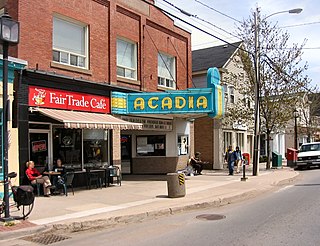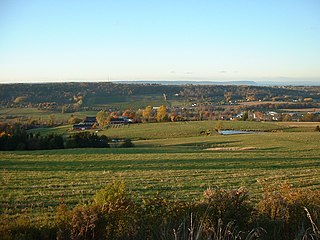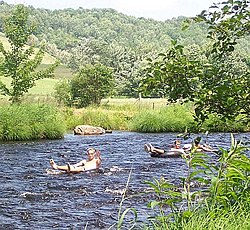
The Annapolis Valley is a valley and region in the province of Nova Scotia, Canada. It is located in the western part of the Nova Scotia peninsula, formed by a trough between two parallel mountain ranges along the shore of the Bay of Fundy. Statistics Canada defines the Annapolis Valley as an economic region, composed of Annapolis County, Kings County, and Hants County.

Wolfville is a Canadian town in the Annapolis Valley, Kings County, Nova Scotia, located about 100 kilometres (62 mi) northwest of the provincial capital, Halifax. The town is home to Acadia University and Landmark East School.

The Bay of Fundy is a bay between the Canadian provinces of New Brunswick and Nova Scotia, with a small portion touching the U.S. state of Maine. It is an arm of the Gulf of Maine. Its tidal range is the highest in the world. The name is probably a corruption of the French word fendu, meaning 'split'.

The Minas Basin is an inlet of the Bay of Fundy and a sub-basin of the Fundy Basin located in Nova Scotia, Canada. It is known for its extremely high tides.

Gaspereau is a rural community located in Kings County, Nova Scotia, Canada.

Grand-Pré is a Canadian rural community in Kings County, Nova Scotia. Its French name translates to "Great/Large Meadow" and the community lies at the eastern edge of the Annapolis Valley several kilometres east of the town of Wolfville on a peninsula jutting into the Minas Basin surrounded by extensive dyked farm fields, framed by the Gaspereau and Cornwallis Rivers. The community was made famous by Henry Wadsworth Longfellow's poem Evangeline and is today home to the Grand-Pré National Historic Site. On June 30, 2012, the Landscape of Grand-Pré was named a World Heritage Site by UNESCO.

The Annapolis River is a Canadian river located in Nova Scotia's Annapolis Valley.

Nova Scotia is a province located in Eastern Canada fronting the Atlantic Ocean. One of the Maritime Provinces, Nova Scotia's geography is complex, despite its relatively small size in comparison to other Canadian provinces.

Tusket is a small fishing community located in Yarmouth County, Nova Scotia on route 308.
Kingsport is a small seaside village located in Kings County, Nova Scotia, Canada, on the shores of the Minas Basin. It was famous at one time for building some of the largest wooden ships ever built in Canada.

The St. Croix River is a river in Nova Scotia entirely contained in Hants and Halifax Counties. Its headwaters are Panuke Lake. The river has been exploited for water power. There were water mills in the nineteenth century and in the 1930s three hydroelectric dams were built; they still operate.

Gaspereau Lake is a lake in Kings County, Nova Scotia, Canada, about 10 km south of the town of Kentville, Nova Scotia on the South Mountain. It is the largest lake in Kings County, and the fifth largest lake in Nova Scotia. The lake is shallow with dozens of forested islands and hundreds of rocky islets (skerries).
Avonport is a community in the province of Nova Scotia, Canada, located in Kings County between the mouths of the Avon River and the Gaspereau River. Early settlers included the Fillis and Reid families. It was part of the Horton Township settlement and was known as Horton Point until its name was changed to Avonport in 1864.
Canard is a rural community occupying a ridge to the north of the Canard River between the Canard and Habitant Rivers in Kings County in the Canadian province of Nova Scotia. The name comes from the French word for duck which was in turn derived from the Mi'kmaw name for the river which described the large numbers of black ducks once found there.

Hortonville is a community in the Canadian province of Nova Scotia, located in Kings County at the mouth of the Gaspereau River and is part of the Landscape of Grand Pré UNESCO World Heritage Site.

Nova Scotia wine is Canadian wine produced in the Canadian province of Nova Scotia. Nova Scotia's wineries are primarily organized under the Wine Association of Nova Scotia, though not all wineries are members. The industry began in the late 1970s with the original Grand Pré Winery in the Annapolis Valley of Nova Scotia.
The Canard River is a river in Kings County, Nova Scotia, Canada which drains into the Minas Basin of the Bay of Fundy between the communities of Canard and Starr's Point. It is known for its fertile river banks and extensive dyke land agriculture.
White Rock is a community in Kings County, Nova Scotia near the town of Wolfville.

The St. Margaret's Bay Hydroelectric System consists of three hydroelectric power plants and the related lake, dam, and river systems driving them. The system is situated within both Lunenburg County and the Halifax Regional Municipality, beginning approximately 2.5 km (1.6 mi) east of the Head of Saint Margarets Bay and approximately 10 km (6.2 mi) southwest of Hammonds Plains. The system is part of the East Indian River watershed and drains 271 square kilometres (105 sq mi), with water storage provided in Lunenburg County by Mill Lake, Coon Pond, Sandy Lake, Wrights Lake, Big Indian Lake, Five Mile Lake and, at times, an overflow from Pockwock Lake in the Halifax Regional Municipality. The system is owned and operated by Nova Scotia Power Inc.
















